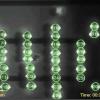Distributed feedback micromanipulation by shaping force fields
We study the problem of distributed planar manipulation by shaping a force field derived from a potential field commanded by an actuator array. The shapes of the spatially continuous fields are commanded through a set of spatially discrete nodes (actuators) such as electrodes in the case of dielectrophroesis, electromagnets in the case of planar magnetic manipulators, or linear piezoelectric actuator in the case of deformable flat surfaces. Distinguished feature of such force fields is that the contribution from an individual actuator usually affects the situation in the neighbouring zones too. As an idealization, the spatial domain is considered unbounded, which yields the set of command signals infinite but countable. Remember that the derived force field is, however, spatially continuous. The object or a number of objects located in the force field are fully described by a finite state vector (position and velocity for each object). Hence we obtain a dynamic system with a finite number of states and a huge and a very specially structured input matrix in the state-space model, which is furthermore dependent on the state vector. The topic of research is to find control strategies for this type of dynamical systems, exploiting their structure.
Apart from the purely theoretical (abstract, algorithmic) research in the area of distributed manipulation, we also recognize the role of laboratory experiments. Perhaps not so much for verification but rather for finding relevant theoretical challenges. An application domain in which we reached certain experimental maturity is dielectrophoresis. In dielectrophoresis, the role of "actuators" is played by an array of electrodes, usually fabricated into some planar pattern such as colinear or rectangular (chess-board) array. Applying independent voltages to the electrodes, an electric field E is created. Nonhomogeneity in E (either in magnitude or phase, or both) leads to a force exerted on uncharged yet polarized particles in the field. In our research we aim at mastering not only theoretical aspects of this electrical phenomena but also the fabrication and experimentation skills.

